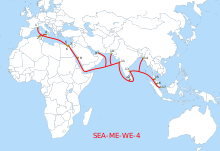SEA-ME-WE 4
| SEA-ME-WE-4 | |
|---|---|
| Cable type | Fiber optic cable |
| operator | 16 |
| Landing points | Landing points |
| overall length | 18,800 km |
| technology | Wavelength division multiplexing |
| active since | December 2007 |
SEA-ME-WE 4 or South-East Asia - Middle East - Western Europe 4 is a submarine cable that connects Europe and Asia . It was put into operation in December 2007. The cable is around 18,800 kilometers long.
The implementation takes place predominantly as a submarine cable system with a short land route in Egypt . Wavelength division multiplexing is used to increase capacity and improve signal quality .
SEA-ME-WE 4 is the fourth of a family of several similarly named large submarine cables to connect Europe with Asia. Other cables are SEA-ME-WE 3 and SEA-ME-WE 5 .
history
SEA-ME-WE 4 was implemented by a consortium of 16 telecommunications companies. The cable system belongs to the SEA-ME-WE series of submarine cables. The first of these cables - SEA-ME-WE 1 - was completed in 1986 as a coaxial cable for the transmission of telephone signals between Europe, the Middle East and Southeast Asia. At the time of its completion, it was the longest telephone cable in the world at 13,585 km and the first such cable to be laid in the Indian Ocean . The maximum bandwidth of this cable was estimated at 25 MHz . Later on, SEA-ME-WE 1 no longer met the increased requirements, which led to follow-up projects. In 1994, SEA-ME-WE 2 was completed as a fiber optic system with a length of 18,751 kilometers. The maximum data transfer rate reached 560 Mbps, which corresponds to about 15 cables of the type SEA-ME-WE 1. In 1999 SEA-ME-WE 3 went into operation with a capacity of 2.5 Gbps. In 2002 this was increased to 10 Gbps.
SEA-ME-WE 4 was laid by the cable laying vessel Niwa in the operations of Emirates Telecommunications and Marine Services . In the first phase, which lasted 101 days, 3500 km of cables were laid at depths of up to 4000 meters from France to the Arabian Sea . The 2004 Indian Ocean tsunami delayed the start of construction on Phase 2, which was directed by Fujitsu and Alcatel Submarine Networks .
On December 13, 2005, Fujitsu announced that the cable had been completed. At the time of its completion, the cable had a maximum data transfer rate of 1.28 Tbps. In 2015 the SEA-ME-WE 4 was upgraded to a capacity of 4.6 Tbps.
topography
The cable has 17 landing points in 15 countries on two continents and is divided into 4 segments:
Segments
- Tuas - Mumbai
- Mumbai - Suez
- Suez - Cairo
- Cairo - Marseille
Landing points
- Marseille , France
- Annaba , Algeria
- Bizerte , Tunisia
- Palermo , Italy
- Alexandria , Egypt
- Cairo , Egypt (land line)
- Suez , Egypt (land line / end)
- Jeddah , Saudi Arabia
- Fujairah , United Arab Emirates
- Karachi , Pakistan
- Mumbai , India
- Colombo , Sri Lanka
- Chennai , India
- Cox's Bazar , Bangladesh
- Satun , Thailand
- Malacca , Malaysia
- Tuas, Singapore
Operating company
| Companies | country |
|---|---|
| Algerie Telecom |
|
| Bharti Airtel (Bharti Infratel Limited) |
|
| Bangladesh Telegraph and Telephone Board (BTTB) |
|
| CAT Telecom |
|
| Etisalat |
|
| MCI Communications (formerly MCI UK) |
|
| Orange (formerly France Télécom) |
|
| Pakistan Telecommunication Company Limited (PTCL) |
|
| Saudi Telecom Company (STC) |
|
| Singapore Telecommunications (SingTel) |
|
| Sri Lanka Telecom (SLT) |
|
| Tata Communications (formerly: Videsh Sanchar Nigam Limited, VSNL) |
|
| Telecom Egypt (TE) |
|
| Telecom Italia |
|
| Telecom Malaysia |
|
| Tunisie Telecom |
|
Intelligence surveillance
In August 2013, the Süddeutsche Zeitung reported that under the leadership of the British secret service GCHQ, with the support of the National Security Agency, access to the cable system had been achieved. The newspaper cites Edward Snowden as the source of this information. According to the news magazine Der Spiegel , the US National Security Agency (NSA) also managed to obtain information about the network management of the submarine cable system.
Web links
- www.seamewe4.com, website of Sri Lanka Telecom ( Memento from August 4, 2007 in the Internet Archive )
- Alexander McLeod, Memorial University of Newfoundland (2013): SEA-ME-WE 4 Fiber Optic Submarine Cable Project
Individual evidence
- ↑ a b NSA taps data cables from Europe to Asia , Deutsche Welle / dpa, December 29, 2013
- ↑ a b Alexander McLeod: SEA-ME-WE 4 Fiber Optic Submarine Cable Project . In: Faculty of Engineering and Applied Science, Memorial University, St. John's, NL, Canada (Ed.): Coastal and Ocean Engineering Undergraduate Student Forum, COASTAL-13 . April 2013 (English, mun.ca ).
- ↑ Fujitsu Completes Construction of SEA-ME-WE 4 Submarine Cable Network: 20,000 kilometers of optical submarine cable network spans from Singapore to France. Fujitsu, December 13, 2005, accessed June 1, 2017 .
- ↑ Mitsubishi Electric Completes Upgrade of SEA-ME-WE 4 Network. Misubishi Electric, December 18, 2015, accessed September 9, 2017 .
- ↑ Cable System Configuration . In: South East Asia-Middle East-Western Europe 4 . Sri Lanka Telecom. Archived from the original on August 4, 2007. Retrieved January 31, 2008.
- ↑ SEA-ME-WE 4 Network Administration system. Seamewe4.net, accessed on November 21, 2016 (English).
- ↑ British secret service siphons data from Germany . In: Süddeutsche Zeitung . August 28, 2013.
- ↑ John Goetz, Hans Leyendecker and Frederik Obermaier (August 28, 2013). "British Officials Have Far-Reaching Access To Internet And Telephone Communications" (accessed August 30, 2013)
- ↑ NSA spies on data cables from Europe to Asia . In: Spiegel Online , December 29, 2013. Retrieved January 5, 2014.

